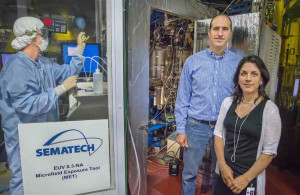
Similar to film used in photography, photoresist is used to lay down the patterns of ever-shrinking lines and features on a surface. In a bid to continue decreasing transistor size while increasing computation and energy efficiency, chip-maker Intel has partnered with researchers from the Molecular Foundry – with contributions from ALS – to design an entirely new kind of resist. And importantly, they have done so by characterizing the chemistry of photoresist, crucial to further improve performance in a systematic way. The researchers believe their results could be easily incorporated by companies that make resist, and find their way into manufacturing lines as early as 2017.
Cross-linking resists have good mechanical stability and do not distort during development, leading to good resolution, but suffer from poor sensitivity. On the other hand, chemically amplified resists generate an acid catalyst that enhances sensitivity but degrades resolution. By using a new small molecule resist matrix, which uses chemically amplified deprotection, and adding a dilute cross-linker, the team was able to demonstrate a path towards a new type of photoresist that combines the best of both worlds.

